Tom Kepler's Blog, page 43
June 24, 2011
David Lynch: "Octopus and Trout"
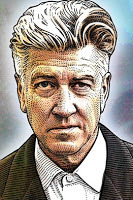 David Lynch, filmmaker and proponent of the Transcendental Meditation technique, speaks at his allegorical best.
David Lynch, filmmaker and proponent of the Transcendental Meditation technique, speaks at his allegorical best.David Lynch Foundation TV is debuting an exclusive interview series known as "Daily David" where David speaks candidly about anything and everything ranging from filmmaking to consciousness. In this video clip, David Lynch gives advice on keeping your trout and octopus separate.This video was embedded from the video on the David Lynch Foundation Television site.
Published on June 24, 2011 08:00
June 20, 2011
A Thousand-Mile Walk to the Gulf, by John Muir: a book review
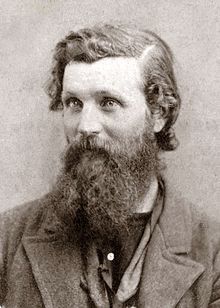 Muir circa 18"Often I thought I would like to explore [New York City] if, like a lot of wild hills and valleys, it was clear of inhabitants."
Muir circa 18"Often I thought I would like to explore [New York City] if, like a lot of wild hills and valleys, it was clear of inhabitants."In September of 1867, age 29, John Muir set out for a walking tour of the South, which extended to Cuba and eventually ended in California. Visiting home in Wisconsin, Muir traveled by train to Jeffersonville, Indiana, crossed the Ohio River into Kentucky, and started walking.
Not a book designed by Muir, this narrative was prepared by William Frederic Bade and copyrighted by Houghton Mifflin Company in 1916, two years after Muir's death, using Muir's original journals, a "typewritten, rough copy of the journal," "two separate elaborations of his experiences in Savannah when he camped there for a week in the Bonaventure graveyard," and an excerpt from a letter summarizing his first visit to Yosemite.
Connecting the time recounted in Muir's autobiography, The Story of My Boyhood and Youth with My First Summer in the Sierra, this is a book about a young man intensely focused on the beauty and wonders of nature, who "botanizes" his way through his 1,000-mile walk, and discusses all else in passing--for instance, the after-effects of the just-ended Civil War. Talk of the Civil War is characterized as interminable "political discussions."
Compiler William Bade comments: "[Muir] apparently intended to use this raw material at some time for another book. If the record, as it stands, lacks finish and adornment, it also possesses the immediacy and the freshness of first impressions."
How does Muir traverse Louisville, Kentucky? "Crossing the Ohio at Louisville [September 2], I steered through the big city by compass without speaking a word to any one."
Those words by Muir pretty much sum up his love for nature and his dislike for what humanity has done to it. He frequently describes leaving a town or homestead as escaping into the forest. "September 5. Escaped from the dust and squalor of my garret bedroom to the glorious forest."`
Muir's 1,000-mile journey includes the following:
horseback guerrilla robbers, holdouts from the Civil Warwhite racists and their interminable complaintsthe ignorance and poverty that followed slavery and the warBlacks who would rob and kill for a few dollarsFlorida and malariaHis account mostly describes, though, the fascinating forests, plains, swamps, and the ocean and their specific flora and fauna. Most of his descriptions of people are of those kind, sharing people, blacks and white, who took in this eccentric lover of nature, who wandered into their homes from the forest.
Muir on his walk is not unaware of the viccitudes of slavery or poverty; he simply acknowledges it but places almost all of his attention on his botanical studies. The journal is more a study of Muir as the "transparent eyeball" that Emerson iterates in his essay "Nature." Muir loved nature, and he followed his bliss.
After having dinner with a Southern family: "Heard long recitals of war happenings, discussion of the slave question, and Northern politics; a thoroughly characteristic Southern family, refined in manners and kind, but immovably prejudiced on everything connected with slavery."
As modern readers, we read Muir's account and realize the struggles of the one hundred years following his walk that were needed to right the wrongs of that time. We even read Muir's words, terms he uses in his discriptions, and realize the difference of those times--even down to a commonly used vocabulary that would not be used today.
My interest in this book was primarily to enjoy Muir's love of God's woods--he was a religious man and saw God's work in nature. However, the candid, unfiltered view of the world from 150 years ago is also fascinating. It is a wonder to follow the journey of an eccentric of the 1870's who was destined to become a prophet of our world of today.
Available as a free ebook:
Internet ArchiveOpen LibraryCopyright 2011 by Thomas L. Kepler, all rights reserved
Review copyright transferred to Creative Commons, via Open Library
Published on June 20, 2011 09:28
June 16, 2011
An Organic Lunch
This is what I found and cooked up for lunch. It's so nice to have more time to cook!

Ingredients from the garden, the cupboard, and refrigerator:
spiral noodlessteamed kale fresh from the garden w/ pumpkin seeds and raisins olive oil w/ herbes de Provenceavocadograted jack cheese (from Radiance Dairy)garnish of chopped cilantro fresh from the gardenlightly saltedslices of fresh chappatiEverything was organic and yummy! Wonderfully fresh vegetables--walk to the garden, cut the vegetables, then cook.

Ingredients from the garden, the cupboard, and refrigerator:
spiral noodlessteamed kale fresh from the garden w/ pumpkin seeds and raisins olive oil w/ herbes de Provenceavocadograted jack cheese (from Radiance Dairy)garnish of chopped cilantro fresh from the gardenlightly saltedslices of fresh chappatiEverything was organic and yummy! Wonderfully fresh vegetables--walk to the garden, cut the vegetables, then cook.
Published on June 16, 2011 07:59
June 14, 2011
Free E-books and Project Gutenberg: enrich your summer reading list
 Everybody likes something for free, and that includes free e-books.
Everybody likes something for free, and that includes free e-books.For some reason, I find it hard to read e-books on my computer, but I find it easy to use my e-reader device. I use a Barnes and Noble Nook. I'm sure other devices are just as good.
The E-Ink reader screen on my version (bought a year ago) is easy to read. The pages are not backlit, so the text is stable and much like on a paper book--at least my eyes think so.
Although I've bought some e-books via the B & N site, most of my books are free public domain e-books.
I've found Project Gutenberg a wonderful place to search for free e-books. The books are available in many formats, including ePub, Kindle, and for mobile devices.
Here are some of the authors I've downloaded:
Zane Grey: His romances are always fun for light reading, and I love his descriptions of nature.Mark Twain: I downloaded Pudd'nhead Wilson, Twain's last novel and quite an interesting read.John Muir: I read My First Summer in the Sierra and am now reading A Thousand-Mile Walk to the Gulf.Charles Dickens, Jane Austen, Arthur Conan Doyle, Jack London, Henry David Thoreau, Edgar Rice Burroughs, H.G. WellsProject Gutenberg lists 36,000 titles and has over 100,000 through its affiliates. (I've found Many Books to be a great source.)
Free e-books are also available through Barnes and Noble and Amazon Kindle.
Enjoy your summer reading. Even if you don't read e-books, seeing the good work Project Gutenberg is doing is time well spent.
Copyright 2011 by Thomas L. Kepler, all rights reserved
Published on June 14, 2011 08:00
June 11, 2011
Jokes: Children Are Quick
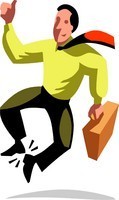 My school superintendent (Head of School) at Maharishi School just sent the teachers a fun and supportive end-of-year email. He closed with a series of jokes that had been emailed to him from a friend.
My school superintendent (Head of School) at Maharishi School just sent the teachers a fun and supportive end-of-year email. He closed with a series of jokes that had been emailed to him from a friend.He said to share them with others, so here they are!
Children Are Quick _______________________________
TEACHER: Maria, go to the map and find North America . MARIA: Here it is. TEACHER: Correct. Now class, who discovered America ? CLASS: Maria. ____________________________________
TEACHER: John, why are you doing your math multiplication on the floor? JOHN: You told me to do it without using tables. __________________________________________
TEACHER: Glenn, how do you spell 'crocodile?' GLENN: K-R-O-K-O-D-I-A-L' TEACHER: No, that's wrong GLENN: Maybe it is wrong, but you asked me how I spell it..
(I Love this child) ____________________________________________
TEACHER: Donald, what is the chemical formula for water? DONALD: H I J K L M N O. TEACHER: What are you talking about? DONALD: Yesterday you said it's H to O. __________________________________
TEACHER: Winnie, name one important thing we have today that we didn't have ten years ago. WINNIE: Me! __________________________________________
TEACHER: Glen, why do you always get so dirty? GLEN: Well, I'm a lot closer to the ground than you are. _______________________________________
TEACHER: Millie, give me a sentence starting with 'I.' MILLIE: I is...TEACHER: No, Millie..... Always say, 'I am.' MILLIE: All right... 'I am the ninth letter of the alphabet.' ________________________________
TEACHER: George Washington not only chopped down his father's cherry tree, but also admitted it. Now, Louie, do you know why his father didn't punish him? LOUIS: Because George still had the axe in his hand.... ______________________________________
TEACHER: Now, Simon, tell me frankly, do you say prayers before eating? SIMON: No, sir, I don't have to; my mom is a good cook. ______________________________
TEACHER: Clyde, your composition on 'My Dog' is exactly the same as your brother's... Did you copy his? CLYDE : No, sir. It's the same dog.
(I want to adopt this kid!!!)
___________________________________
TEACHER: Harold, what do you call a person who keeps on talking when people are no longer interested? HAROLD: A teacher
And as a closing remark, for that last joke, I have to say "Ouch!"
Published on June 11, 2011 17:43
June 7, 2011
River Dream Prose Poem
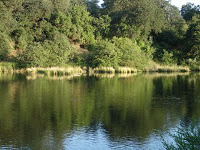 Beneath the hackberry tree, we ride a child's plastic swimming pool through summer heat, my son and I, he about three years old, a small, concentrated squirm of wet squeals. Leaves filter the light, the water cools and plashes, child's voice like a chattering jay. And then the pool is inside the house, I painting the wall, my son's first-time vision witnessing the roller's movement, the wet color applied. He rubs his face along the roller; I help wash the paint off, explaining it is meant to stay, to linger like a memory. Brushes change, I'm painting a landscape, a child's swimming pool floating on a river, a dream, liquid, conscious color on a greater expanse of river. Sky paints a brilliant blue, sun shines yellow, shoreline a distant green of loam. Silence bustles: lap of wave, sough of wind, the calling of birds. We lean out the window of our boat, our pool, our home, the living waters of our living--my son's arm and hand on my shoulder, we of the same water, of the same waters as the river, river unwinding to the horizon, a silent movement of stillness: sunshine glowing leaves of a larger tree, sky a deep breath of blue: my voice, my child's voice, innocent as birdsong crying the beauty of the day.
Beneath the hackberry tree, we ride a child's plastic swimming pool through summer heat, my son and I, he about three years old, a small, concentrated squirm of wet squeals. Leaves filter the light, the water cools and plashes, child's voice like a chattering jay. And then the pool is inside the house, I painting the wall, my son's first-time vision witnessing the roller's movement, the wet color applied. He rubs his face along the roller; I help wash the paint off, explaining it is meant to stay, to linger like a memory. Brushes change, I'm painting a landscape, a child's swimming pool floating on a river, a dream, liquid, conscious color on a greater expanse of river. Sky paints a brilliant blue, sun shines yellow, shoreline a distant green of loam. Silence bustles: lap of wave, sough of wind, the calling of birds. We lean out the window of our boat, our pool, our home, the living waters of our living--my son's arm and hand on my shoulder, we of the same water, of the same waters as the river, river unwinding to the horizon, a silent movement of stillness: sunshine glowing leaves of a larger tree, sky a deep breath of blue: my voice, my child's voice, innocent as birdsong crying the beauty of the day.Copyright 2011, by Thomas L. Kepler, all rights reserved
Published on June 07, 2011 03:39
June 1, 2011
Our Garden: gardening with trellises
I like the look of a garden that rises above the group with the use of trellises.
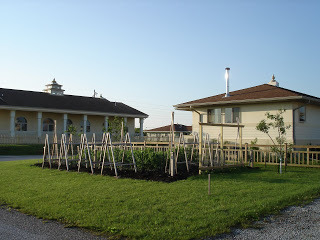 north of our house Not only is space used more efficiently to boost the production of the garden, but that openness and increased use of space allows for more air flow, decreasing the spread of disease--in my opinion, anyway.
north of our house Not only is space used more efficiently to boost the production of the garden, but that openness and increased use of space allows for more air flow, decreasing the spread of disease--in my opinion, anyway.
Here are some photos of my garden from Memorial Day weekend.
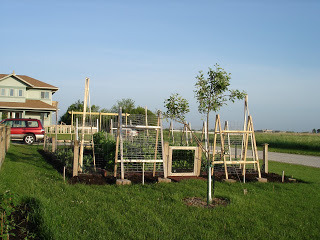 a view from the east
a view from the east
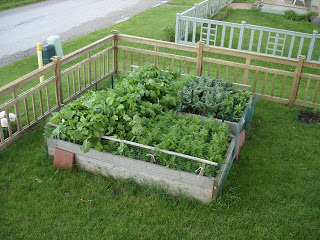 in the southeast corner of our yard We are using the A-frame trellises for butternut squash and cucumbers. The vertical lattice that uses twine for runners is for Kentucky Wonder pole green beans.
in the southeast corner of our yard We are using the A-frame trellises for butternut squash and cucumbers. The vertical lattice that uses twine for runners is for Kentucky Wonder pole green beans.
The 4 x 8 raised bed growing boxes were built because the underground cables to our house all pass over that spot. Rather than just growing grass since we couldn't dig down, we decided to grow above the soil level with raised beds.
We have been eating greens out of our garden for about two months, since we covered the raised beds with plastic in March to warm them. Last year, we had fresh greens from the same beds in November. We hope to extend our season as much as possible.
Copyright 2011 by Thomas L. Kepler, all rights reserved
 north of our house Not only is space used more efficiently to boost the production of the garden, but that openness and increased use of space allows for more air flow, decreasing the spread of disease--in my opinion, anyway.
north of our house Not only is space used more efficiently to boost the production of the garden, but that openness and increased use of space allows for more air flow, decreasing the spread of disease--in my opinion, anyway.Here are some photos of my garden from Memorial Day weekend.
 a view from the east
a view from the east in the southeast corner of our yard We are using the A-frame trellises for butternut squash and cucumbers. The vertical lattice that uses twine for runners is for Kentucky Wonder pole green beans.
in the southeast corner of our yard We are using the A-frame trellises for butternut squash and cucumbers. The vertical lattice that uses twine for runners is for Kentucky Wonder pole green beans.The 4 x 8 raised bed growing boxes were built because the underground cables to our house all pass over that spot. Rather than just growing grass since we couldn't dig down, we decided to grow above the soil level with raised beds.
We have been eating greens out of our garden for about two months, since we covered the raised beds with plastic in March to warm them. Last year, we had fresh greens from the same beds in November. We hope to extend our season as much as possible.
Copyright 2011 by Thomas L. Kepler, all rights reserved
Published on June 01, 2011 04:16
May 24, 2011
Backlists, Self-publishing, Breakout Novels, and "The Dream"
 Backlists
Backlists Writing online for Forbes, author Alan Rinzler states: "Savvy writers – especially those with an online following — are reveling in unexpected profits by self-publishing their defunct backlist titles as new e-books." ("Is there gold in your backlist? Self-publish and find out!")
Established author and self-publishing author J.A. Konrath writes in a blog post this tidbit: "More than 95% of everything ever published has gone out of print . . . But Out-Of-Print does not equal Worthless. There is still money to be made on old books. That's why there's a billion dollar used book industry." He is currently helping author friend Robert Walker put his 40 out-of-print novels onto Kindle, "books that were with big houses, which had big print runs and distribution."
Self-publishing
Konrath's blog post "Status Quo Vadis?" contains some interesting comments, though.
An anonymous comment adds:
I think before you [from a previous comment] post anything else on this topic, you should have to judge a writing contest of no less than 1000 entries, and then come back here with a straight emoticon and tell everyone that the vetting process provided by NY publishing is meaningless.Konrath then adds: "Dude, I've read over 10,000. And 1 of them was worthy of publication, in my professional opinion."
I agree [publishers] don't really know what to do with e-rights, but trad publishing is still without a doubt the very best way to break into the business of writing (as opposed to becoming your own publisher/publicist/art department/editor/copy editor/sub rights department/literary agent, which is what most people reading this blog do or want to do."
The consensus still seems to be that traditional publishing is still the best way to "earn your spurs" as a writer and to gain credibility in the publishing world.
Breakout Novels
Novelist Jeremy Robinson discusses publishing e-books through Kindle in a guest blog post, but his comments apply to paper books self-published, also.
So what about that advice I promised you? It's two fold. Part one is simple, take risks. Jump in. You have nothing to lose. Seriously. You're not going to blow a future print deal by self-publishing an e-book. The numbers aren't tracked by Bookscan. You can make the book disappear with the click of a button. At the same time you might just sell enough to entice a publisher to make a sweet offer (if print is your goal). If you fail, pull the book and send it back to the slushpile.
Part two is not so simple. Do it right. I'm not saying I've done everything right. I make plenty of mistakes. But I am dedicated to putting out books that rival those produced by the big publishers in every way. I want my covers, my interiors and my story and writing quality to match, or beat, those produced by the big guns. And you should too. If you don't, you're not going to sell. You're going to be disappointed and you might just give up on your dreams. Don't be afraid to pay for a cover. To hire an editor. You might spend $1000, even $2000, getting your book ready, but if you don't believe you can sell the 500 - 1000 copies of your book at $2.99 and make that money back you shouldn't be self-publishing. If you don't believe the book will sell, it probably won't. Don't half-ass it.Robinson, though, is an author who has been traditionally published. So self-publishing won't work for unknown authors, right? Robinson continues in the article:
Now, the first thing critics are going to point out is that I, like Joe, and am established mid-list author so that must be why my e-books are selling well. This couldn't be further from the truth. Keep in mind that I was selling lots of books long before I had a traditional print deal. My books sell because I work like a bastard. I do my book covers (even Thomas Dunne asked for my help on the covers), website, interiors, marketing and PR, never mind writing the books. The only thing I don't do is edit. If anything, my hardcovers sell well because of my self-publishing efforts.The Dream
Konrath discusses in the same article the status of traditional publishing and "being validated."
We've had it drilled into our heads that the only way to succeed is to follow the age old formula of: write a book, send out queries, get an agent, hope for a book deal.Konrath closes with these comments:
Robinson, and most of my peers, have been conditioned to believe publishers are essential. And they still believe this, even though they aren't essential anymore. If we look at Robinson's five reasons for sticking with his publisher, they fall right in with the dream that publishers have been selling us for years: hope for a bestseller, the importance of an editor, getting into bookstores, the chance of huge success. Even the vanity of having a hardcover version has always been a carrot on the stick for authors. I know several authors with paperback deals who have pursued a hardcover deal for years, simply because of the prestige of having a hardcover.
Now, I don't discount that if a book is accepted by the Big 6, it meets a minimum quality standard. It is difficult for writers to judge their own work, and acceptance by an agent is a good indicator that the work is up to par.Robinson refers to writing and publishing as a "marathon." Self-publishing is one means to gaining readership, and so is traditional publishing. What I like about these comments is that nowadays it appears that self-publishing and traditional publishing are not mutually exclusive.
But guess what? Selling a shitload of ebooks is a much better validation. Getting a stamp of approval from readers is more important than a stamp of approval from a publisher.
This is a business. When I see writers acknowledging that they'll probably earn less money by signing with a publisher, but still wanting to do it, I plainly see how much publishers have perverted how writers think.
Establishing a writer's website, in my opinion, requires reader access to a product to buy. Whether that product comes to the reader through self-publishing or traditional publishing, I feel the paper book or e-book to be vital to the writer's web platform.
How can you have a readership, after all, if you've provided the reader nothing to read?
Copyright 2011 by Thomas L. Kepler, all rights reserved
Published on May 24, 2011 04:08
May 22, 2011
Book Review: Dies the Fire, an alternative history
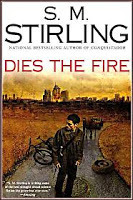 Dies the Fire
Dies the Fire
What happens when the lights go out . . . for good?
The Change occurred when an electrical storm centered over the island of Nantucket produced a blinding white flash that rendered all electronic devices and firearms inoperable--and plunged the world into a dark age humanity was unprepared to face . . .
S.M. Stirling has written a trilogy of novels about how humanity adapts to the sudden, catastrophic change in potentialities: where, basically, the technologies of medieval times are all that "work"--an artificial imposition on our planet, imposed by an unknown source--labeled "alien space bats" by one wit.
The three novels of this series are Dies the Light
 ,
The Protector's War
,
The Protector's War
 , and
A Meeting at Corvallis
, and
A Meeting at Corvallis
 .
.Stirling's website describes the series in the following manner:
A trilogy set in the world that the island of Nantucket left behind when it became an "Island in the Sea of TimeThe effects of this imposition are anything buy funny, though. Food is the immediate pressure for Change Year 1. How to grow food and keep others from taking it organize CY2. As the years progress and the trilogy plays out the conflicts, Stirling's vision focuses on several groups that survive--some life-supporting, and some life-destroying.". This world is hit by "The Change" causing electricity, high gas pressures, and fast combustion (including explosives and gunpowder) to stop working.
The most interesting aspect of the trilogy is who survives. Stirling emphasizes luck as being essential, and also an early-on recognition that the Change wasn't changing back. Those who adapt early make decisions that lead to survival--getting out of big cities and away from the masses of hungry people, finding a protected spot to survive long enough to put some seed into the ground.
Interesting characters--including dynamic, strong, and charismatic women characters--make these novels worth reading.
Mike Havel, a former Marine, whose small plane conks out while flying over the Bitterroot Mountains, who eventually organizes the "BearKiller Outfit"Juniper Mackenzie, a Celtic musician and Wiccan priestess who says that in order to survive, a clan must be formed--and that's just what happens, kilts and allNorman Arminger, a history professor and medieval re-enactment buff who decides the Change is an opportunity to bring back the Middle Ages--and guess who will be king?Astrid Larsson, who deals with the Change by becoming an elf-like warrior princess right out of J.R.R. TolkienEilir Mackenzie, Juniper's daughter, who is deaf and mute, but who finds abilities that allow her to move through the changed world with a grace and power that creates the perfect complement to Astrid Larsson's fantasySam Aylward, from British Yorkshire, former Special Forces soldier, who happens to know how to make yew bows in the ancient mannerStirling has chosen an alternative history that begins with a catastrophic upheaval and tumble-down of human society. Out of that, a time filled with fighting for survival ensues. I find his vision an interesting exercise for the imagination--and a thrilling read. I don't agree completely with his vision--I tend to think there would be more cooperation and less head-bashing insanity, for instance, but the basic premise of a return to low-technology existence and how new cultures are formed is developed by Stirling into a stirring story of derring-do and back-to-the-land adventure.
Copyright 2011 by Thomas L. Kepler, all rights reserved
Published on May 22, 2011 05:17
May 18, 2011
Student-based Education and Project-based Learning
 How do you fit a round peg into a square hole?
How do you fit a round peg into a square hole?For many teachers, that is the basic challenge of education.
The traditional classroom is the square peg--and I mean the classroom--the desks and the chalkboard/whiteboard at the front. Students don't want to sit and receive; they want to do-- to be actively engaged in their education.
Consciousness-Based Education lists five Fundamentals of Education:
ReceptivityIntelligence KnowledgeExperienceExpressionNote that the first is receptivity. If the student isn't ready or interested, good luck, teacher.
At Maharishi School, where students and faculty practice the Transcendental Meditation technique, there is the advantage of less student stress, more curiosity, and greater creativity.
Even with the TM advantage, a school still has to center education around the student. This is a continuing challenge and inspiration for all educators.
One educator who has addressed this challenge is Ron Berger in his book An Ethic of Excellence.
And how many of the students have a smart phone or iPod in their pockets or backpacks?
How many students are used to learning in a highly self-organized manner and then are asked in school to learn in a lock-step manner that differs from their learning by choice?
And then one more point: how many students, given their maturity level, simply say, "I don't want to learn that," even if the that is some essential component of learning.
Welcome to the life of an educator.
Dr. William Glasser
 said that if students don't want to learn, we can't teach them. They should be allowed to leave the classroom and come back with their friends when they are ready.
said that if students don't want to learn, we can't teach them. They should be allowed to leave the classroom and come back with their friends when they are ready.How does this fit in, though, with the pressures of standardized testing? Even when teachers are compelled to teach for the test, students are under no obligation to learn for the test, especially students in their early years. They're just kids, after all.
Below is a video that illustrates (literally) the dilemma faced by educators.
I keep coming back to the Fundamentals of Education and how Consciousness-Based Education is structured at Maharishi School and Maharishi University of Management.
Enliven the mind through TM and by structuring a creative, rigorous class environment so that the child is receptive to learning something new. Facilitate the interaction of the intelligence of the students . . . . . . with the content knowledge. Provide the experience of being actively engaged in the subject matter--that means creatively using the knowledge. Complete the learning experience with an authentic expression of the students' learning, a demonstration of their mastery of the content and skills being learned.Receptivity Intelligence Knowledge Experience Expression
Copyright 2011 by Thomas L. Kepler, all rights reserved
Published on May 18, 2011 04:11



